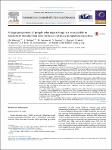A large proportion of people who inject drugs are susceptible to hepatitis B: Results from a bio-behavioural study in eight German cities
Haussig, Joana M.
Nielsen, Stine
Gassowski, Martyna
Bremer, Viviane
Marcus, Ulrich
Wenz, Benjamin
Bannert, Norbert
Bock, Claus-Thomas
Zimmermann, Ruth
Background: People who inject drugs (PWID) are at high risk of hepatitis B virus (HBV) infection by sharing needles and drug use paraphernalia. In Germany, no routine surveillance of HBV prevalence and vaccination coverage among PWID exists. Methods: Socio-demographic and behavioural data were collected between 2011 and 2014 through face-to-face interviews, during a bio-behavioural survey of PWID recruited in eight German cities. Dried blood spots (DBS) prepared with capillary blood were tested for HBV markers. Factors associated with past/current HBV infection and vaccination status were analysed by univariable and multivariable analysis using logistic regression. The validity of self-reported HBV infection and vaccination status was analysed by comparison to the laboratory results. Results: Among 2077 participants, the prevalence of current HBV infection was 1.1%, of past HBV infection was 24%, and of vaccine-induced HBV antibodies was 32%. No detectable HBV antibodies were found in 43%. HBV infection status was significantly associated with study city, age, years of injecting, use of stimulants, migration status, and homelessness; HBV vaccination status was significantly associated with study city, age, and level of education. Correct infection status was reported by 71% and correct vaccination status by 45%. Conclusions: HBV seroprevalence among PWID was about five times higher than in the general population in Germany, confirming PWID as an important risk group. Targeted information campaigns on HBV and HBV prevention for PWID and professionals in contact with PWID need to be intensified. Routinely offered HBV vaccination during imprisonment and opioid substitution therapy would likely improve vaccination rates among PWID.
Dateien zu dieser Publikation
Keine Lizenzangabe

